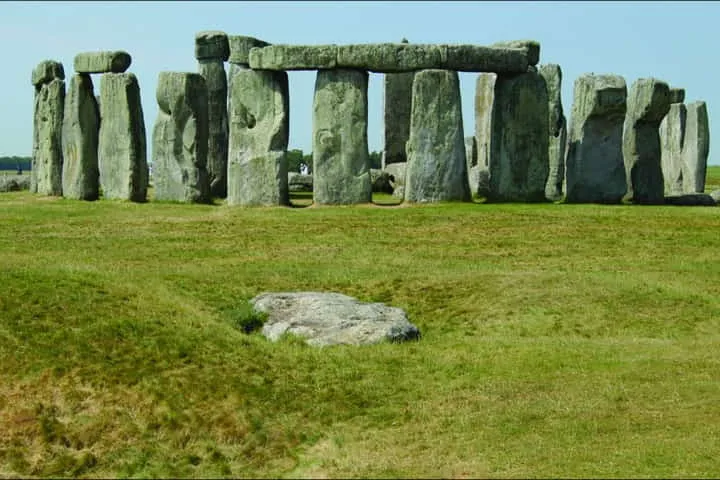

Going beyond the size and scale of Stonehenge, researchers have found out how it acts as a solar calendar (Pic. Courtesy Twitter/@SPACEdotcom)
<p>
<strong>The sheer size and magnitude of Stonehenge built between 3000 BC and 2000 BC makes it enigmatic. Yet it was not merely for show, for scientists always believed it to be an ancient calendar because of its alignment with the solstices of summer and winter.</strong></p>
<p>
Till now how the calendar worked was not known but a recent study shows that it performed like the ones used in ancient Egypt with 365.25 days in a year, as per a report in newscientist.com. Each of the stones present in the large sarsen circle denotes a day of the month.</p>
<p>
Sharing details about it, Tim Darvill of United Kingdom&rsquo;s Bournemouth University who did the study said: <a href="https://www.newscientist.com/article/2310095-stonehenge-may-have-been-a-giant-calendar-and-now-we-know-how-it-works/" rel="nofollow">&ldquo;It&rsquo;s a perpetual calendar that recalibrates</a> every winter solstice sunset.&rdquo; The details of the research were published in the academic journal Antiquity.</p>
<p>
The structure would have enabled the people of ancient times living in the area of what is today Wiltshire, UK, to keep count of the days and months of the year.</p>
<p>
When in 2020 it was uncovered that most of the sarsen stones were extracted from the same location which is 25 kilometres from Stonehenge, and placed there almost around the same time, it provided clues to finding out how the calendar worked. &ldquo;All except two of the sarsens at Stonehenge come from that single source, so the message to me was that they&rsquo;ve got a unity to them,&rdquo; observed Darvill.</p>
<p>
This, according to him, pointed out that all this effort was for a single objective and to unravel it, the hunt for clues started.</p>
<p>
It was found that the sarsens had three different formations. Large stone circles numbering 30 were predominant, then there were four &ldquo;station stones&rdquo; &ndash; found outside the circle in a rectangular formation, and the remaining were five trilithons, found inside the stone circle. The last have two vertical stones, with a third one placed horizontally on top.</p>
<p>
<strong>Also read: <a href="https://www.indianarrative.com/culture-news/instead-of-turning-them-into-chocolate-mayan-people-used-cacao-seeds-as-money-147538.html">Instead of turning them into chocolate, Mayan people used cacao seeds as money</a></strong></p>
<p>
Elaborating on this, Darvill said: &ldquo;30, 5 and 4 are interesting numbers in a calendrical kind of sense. Those 30 uprights around the main sarsen ring at Stonehenge would fit very nicely as days of the month. Multiply that by 12 and you get 360, add on another 5 from the central trilithons you get 365.&rdquo;</p>
<p>
In order to get the solar year right, one extra leap day every four years is required and for that Darvill feels the four station stones were placed to keep track. The solstices of the summer and winter were detected using these pairs of stones.</p>
<p>
According to University of Brighton&rsquo;s David Nash, this system &ldquo;makes a lot of sense&rdquo;. &ldquo;I like the elegant simplicity of it.&rdquo;</p>
<p>
Some differ on this issue like Mike Parker Pearson of London&rsquo;s University College. &ldquo;It&rsquo;s certainly intriguing but ultimately it fails to convince. The numbers don&rsquo;t really add up &ndash; why should two uprights of a trilithon equal one upright of the sarsen circle to represent 1 day? There&rsquo;s selective use of evidence to try to make the numbers fit.&rdquo;</p>
<p>
The use of a calendar with 30-days a month and an extra &ldquo;intercalary&rdquo; month of five days was prevalent in ancient Egypt from around 2700 BC.</p>
<p>
<strong>Also read: <a href="https://www.indianarrative.com/culture-news/ancient-egyptians-celebrated-peace-and-prosperity-of-king-amenhotep-iii-in-grand-style-145515.html">Ancient Egyptians celebrated peace and prosperity of King Amenhotep III in grand style</a></strong></p>
<p>
Based on the alikeness of Stonehenge calendar and the ancient Egyptian one suggests that the basic concept may have come from outside. Lending support to this are recent archaeological findings including that of Amesbury Archer, who is buried five kilometres from the Stonehenge and whose isotope analysis disclosed that he was born in the Alps and came to Britain as a youngster. Also, a red glass bead which seems to be made in Egypt around 2000 BC was also found two kilometres from the monument.</p>
<p>
This does not convince Sacha Stern who is University College, London&rsquo;s expert in ancient calendars. &ldquo;I wonder if you need to invoke the Egyptians. Why can&rsquo;t we just imagine that [the people who built Stonehenge] created the whole system by themselves? They certainly knew when the solstice was, and from that point onwards you just have to count the days, and it won&rsquo;t take long to figure out how many days you need in the year.&rdquo;</p>
Brazilian President Luiz Inacio Lula da Silva on Wednesday (local time) issued a firm response…
An earthquake of magnitude 4.4 struck Jhajjhar district in Haryana on Thursday morning, according to…
Prime Minister Narendra Modi on Wednesday received a standing ovation and non-stop applause from lawmakers…
Hailing the relations between India and Africa, Prime Minister Narendra Modi stated that the ties…
At a time when Operation Sindoor against Pakistan is still ongoing, India is looking to…
India and Namibia exchanged MoUs in the presence of Prime Minister Narendra Modi and the…